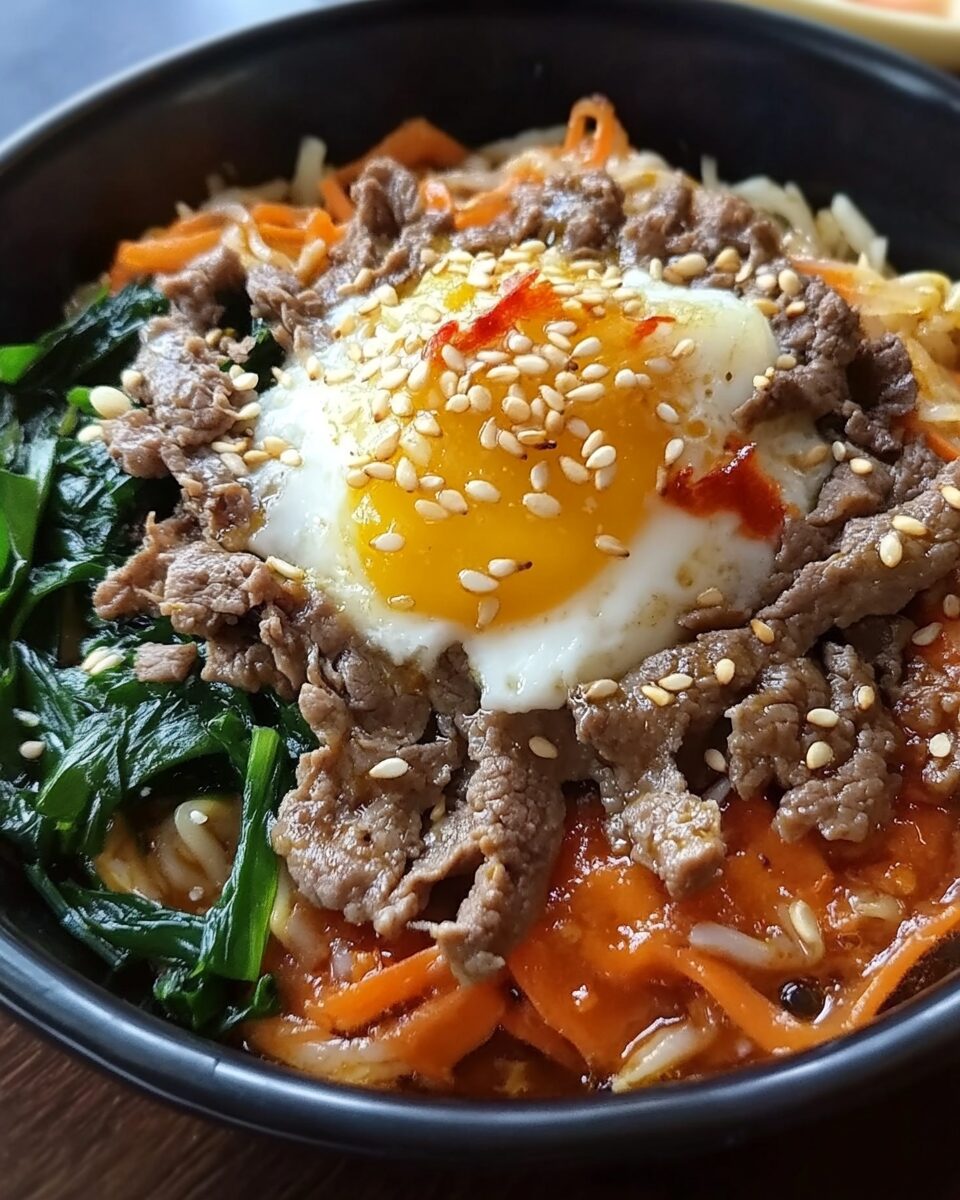Dol Sot Bi Bim Bap, translating to “hot stone bowl with mixed rice,” is a classic Korean dish that brings together warm rice, sautéed vegetables, marinated beef, and a fried egg, all served in a sizzling stone bowl. The combination of textures and flavors, enhanced by the heat of the bowl, makes this a delightful and interactive meal.
Full Recipe:
Ingredients
- ½ cup soy sauce
- ½ cup white sugar
- ½ cup brown sugar
- ¼ cup minced garlic
- ⅓ cup chopped green onion
- 4 tablespoons toasted sesame seeds
- 20 ounces rib-eye steak, thinly sliced
- Salt and pepper to taste
- 3 cups uncooked glutinous (sticky) white rice, rinsed
- 6 ½ cups water
- 4 dried shiitake mushrooms
- 1 pound fresh spinach, washed and chopped
- 12 ounces cucumber, julienned
- 12 ounces carrots, julienned
- Sesame oil
- 8 ounces fresh bean sprouts
- 6 eggs, fried
- 6 sheets nori, crumbled
- 6 tablespoons sesame oil
- ¼ cup chili bean paste (Kochujang)
Directions
-
Marinate the Beef: In a large bowl, combine soy sauce, white sugar, brown sugar, minced garlic, chopped green onions, and toasted sesame seeds. Add the thinly sliced rib-eye steak to the marinade, season with salt and pepper, and mix well. Cover and refrigerate for at least 2 hours.
-
Cook the Rice: In a saucepan, bring the rinsed glutinous rice and 6 ½ cups of water to a boil over high heat. Reduce the heat to medium-low, cover, and simmer until the rice is tender and the liquid has been absorbed, about 20 to 25 minutes.
-
Prepare the Stone Bowls: Preheat the oven to 425°F (220°C). Place 6 Korean stone bowls in the oven to heat.
-
Rehydrate the Mushrooms: In a small bowl, soak the dried shiitake mushrooms in ½ cup of hot water until pliable, about 10 minutes. Remove the stems and thinly slice the caps; set aside.
-
Blanch the Spinach: Bring a saucepan of water to a boil. Add the chopped spinach and blanch just until wilted, then drain and pat dry. Set aside.
-
Season the Vegetables: In a bowl, combine the julienned cucumber and carrots; season with salt and pepper. Set aside.
-
Sauté the Vegetables: Preheat a wok over medium-high heat. Add a small amount of sesame oil and sauté the carrots and cucumbers until softened. Remove and set aside. In the same wok, add a bit more sesame oil and sauté the spinach for 1 to 2 minutes; remove and set aside.
-
Cook the Beef: In the same wok, add the marinated beef along with its marinade. Cook, stirring frequently, until the liquid reduces and the beef is cooked through, about 4 to 5 minutes.
-
Assemble the Bowls: Carefully remove the heated stone bowls from the oven. Add 1 tablespoon of sesame oil to each bowl, swirling to coat the bottom and sides. Place a portion of cooked rice into each bowl, pressing down slightly to create a crust on the bottom. Arrange the sautéed vegetables, cooked beef, bean sprouts, and sliced shiitake mushrooms on top of the rice. Place a fried egg on top of each bowl and garnish with crumbled nori. Serve with chili bean paste (Kochujang) on the side.
Nutrients
Note: Nutritional values are approximate and may vary based on ingredient brands and preparation methods.
- Calories: Approximately 800 kcal per serving
- Protein: 35g
- Carbohydrates: 90g
- Fat: 30g
- Saturated Fat: 8g
- Cholesterol: 220mg
- Sodium: 1500mg
- Fiber: 5g
- Sugar: 15g
The History of Dol Sot Bi Bim Bap
The origins of Bi Bim Bap date back hundreds of years and are deeply rooted in Korean culture. Traditionally, Bi Bim Bap was enjoyed during the eve of the Lunar New Year as a way to use up leftover side dishes before preparing fresh meals for the new year. Over time, this humble dish evolved into a national favorite, enjoyed in both home kitchens and restaurants.
Dol Sot Bi Bim Bap, the hot stone bowl variation, became popular as a way to elevate the dish by adding an extra layer of texture and warmth. The use of a stone bowl ensures that the rice stays warm throughout the meal while creating the signature crispy bottom layer that is highly sought after by food lovers.
Why Dol Sot Bi Bim Bap Stands Out
There are many reasons why Dol Sot Bi Bim Bap is a standout dish in Korean cuisine:
-
Perfect Balance of Flavors: This dish brings together savory, sweet, spicy, and umami flavors in every bite. The marinated beef is rich and slightly sweet, the vegetables are fresh and slightly crunchy, the egg adds creaminess, and the Kochujang (spicy red pepper paste) adds the perfect level of heat.
-
Textural Contrast: The sizzling stone bowl creates a crispy rice layer at the bottom, while the mix of vegetables, egg, and beef provide a variety of textures that make every bite exciting.
-
Highly Customizable: While traditional Dol Sot Bi Bim Bap features beef, spinach, carrots, cucumbers, mushrooms, and bean sprouts, the dish can easily be adapted to fit different dietary needs. It can be made vegetarian by substituting tofu for beef or made spicier by adding extra chili paste.
-
Interactive Eating Experience: Unlike other rice dishes that come pre-mixed, Dol Sot Bi Bim Bap allows diners to mix the ingredients themselves, ensuring a personalized flavor experience.
Health Benefits of Dol Sot Bi Bim Bap
This dish is not only delicious but also packed with nutritional benefits. It includes a variety of fresh vegetables that are high in fiber, vitamins, and minerals. The addition of beef provides protein, while the egg adds healthy fats and essential amino acids.
- Rich in Protein: The beef and egg provide high-quality protein, essential for muscle growth and repair. For vegetarians, replacing beef with tofu or tempeh can still provide a good source of protein.
- Nutrient-Dense Vegetables: Carrots, spinach, mushrooms, and bean sprouts are all rich in essential vitamins and minerals. These ingredients support immune health, digestion, and overall well-being.
- Heart-Healthy Fats: Sesame oil, which is commonly used in this dish, contains heart-healthy unsaturated fats that help lower cholesterol and support heart health.
- Good Source of Fiber: The combination of vegetables and rice ensures that Dol Sot Bi Bim Bap is a good source of dietary fiber, which aids digestion and keeps you full longer.
Cultural Significance of Dol Sot Bi Bim Bap
Bi Bim Bap is a staple in Korean households and is often associated with celebrations and gatherings. It represents unity and harmony because it brings together different ingredients that are mixed into one dish. It’s commonly eaten on special occasions, including birthdays and holidays, as a symbol of prosperity and good fortune.
In Korean culture, food is deeply tied to well-being, and Dol Sot Bi Bim Bap is an excellent example of the balance that Korean cuisine strives for. The dish features a variety of colors, textures, and flavors, reflecting the traditional Korean belief that a well-balanced meal contributes to overall health and happiness.
How to Enjoy Dol Sot Bi Bim Bap Like a Pro
If you are eating Dol Sot Bi Bim Bap for the first time, here are some tips to enhance your experience:
- Mix Thoroughly: The key to getting the best flavor is to mix all the ingredients well before eating. This ensures that every bite has a perfect balance of rice, vegetables, beef, egg, and sauce.
- Adjust the Spice Level: The amount of Kochujang (red pepper paste) can be adjusted based on personal preference. If you prefer a milder taste, use less paste or mix it with a little soy sauce and sesame oil to tone down the heat.
- Enjoy the Crispy Rice: The best part of Dol Sot Bi Bim Bap is the crispy rice at the bottom of the stone bowl. To get the perfect crunch, let the rice sit in the hot bowl for a minute before mixing.
- Pair with Side Dishes: Traditional Korean meals are often served with small side dishes (banchan) such as kimchi, pickled radish, and seasoned seaweed. These additions enhance the overall meal experience.
Modern Variations of Dol Sot Bi Bim Bap
While the traditional version remains popular, chefs and home cooks around the world have put their own twist on this classic dish:
- Vegetarian and Vegan Versions: Many people substitute beef with tofu, tempeh, or extra mushrooms to create a plant-based version of the dish.
- Seafood Bi Bim Bap: Some variations include shrimp, squid, or salmon for a fresh seafood twist.
- Fusion Bi Bim Bap: Western adaptations include ingredients such as avocado, cheese, or even a fried chicken topping for a unique spin.
Conclusion
Dol Sot Bi Bim Bap is more than just a meal—it’s a celebration of flavors, textures, and cultural heritage. From its historical origins to its modern-day popularity, this Korean classic continues to be a favorite for food lovers worldwide. Whether you enjoy it in a restaurant or make it at home, Dol Sot Bi Bim Bap offers a delicious and satisfying dining experience. Its versatility allows for endless variations, making it accessible to people with different dietary preferences.

